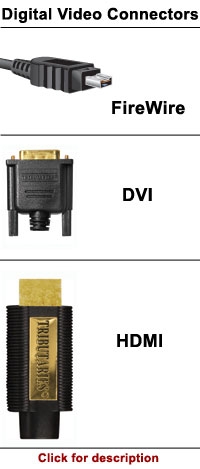Basic Cable: Choosing the Right Cables for Your System Page 5
 Video Cable Types Video interconnects come in a number of flavors. Anyone with a cable box will recognize coaxial RF cable - also called RG-6 - which is most often used to send RF-modulated audio and video from your cable or satellite company into your home. (The slightly thinner RG-59 is also used sometimes.) RG-6 is usually terminated with a round pin F connector (which never seems to thread properly onto the connector on the back of your TV). Composite video - the cable with the familiar yellow RCA plug - is the lowest-quality pure video cable, since it sends all the video information via a single wire. An S-video, or Y/C, connection, which has a circular 4-pin plug, will give you better quality than composite video since it keeps the luminance (brightness) and chrominance (color) information separate.
Video Cable Types Video interconnects come in a number of flavors. Anyone with a cable box will recognize coaxial RF cable - also called RG-6 - which is most often used to send RF-modulated audio and video from your cable or satellite company into your home. (The slightly thinner RG-59 is also used sometimes.) RG-6 is usually terminated with a round pin F connector (which never seems to thread properly onto the connector on the back of your TV). Composite video - the cable with the familiar yellow RCA plug - is the lowest-quality pure video cable, since it sends all the video information via a single wire. An S-video, or Y/C, connection, which has a circular 4-pin plug, will give you better quality than composite video since it keeps the luminance (brightness) and chrominance (color) information separate.
But composite- and S-video cables can't carry high-def video. For that, you'll need a component (a.k.a. YPbPr) or RGB connection. Component video uses three coax cables, with one carrying the luminance signal (Y), which indicates brightness, and the other two carrying "color difference" signals (blue minus luminance, or B - Y, and red minus luminance, or R - Y). Almost every HDTV has at least one or two analog component-video inputs. RGB video, used mainly in front projectors and monitors, is typically terminated with a 15-pin VGA connector, although RCA or BNC connectors are options. The RGB+H/V format used in home theater systems has five cables: three in the manner of component video, plus one each for horizontal (H) and vertical (V) sync data.




























































